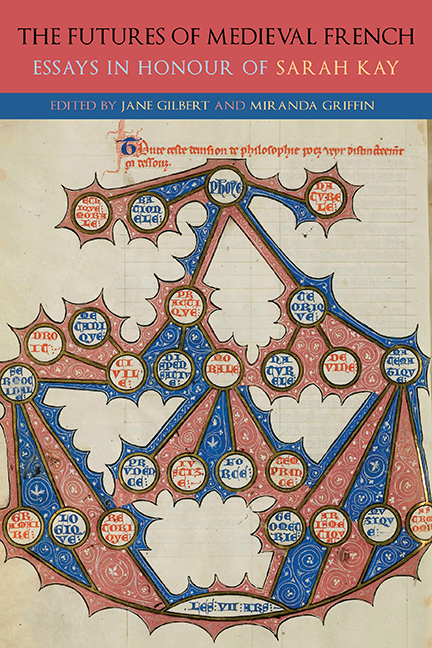Book contents
- Frontmatter
- Dedication
- Contents
- List of Illustrations
- List of Contributors
- List of Abbreviations
- Introduction
- Part I Subjectivity in Troubadour Poetry
- Part II The ‘Chansons de geste’ in the Age of Romance: Political Fictions
- Part III Courtly Contradictions: The Emergence of the Literary Object in the Twelfth Century
- Part IV The Place of Thought: The Complexity of One in French Didactic Literature
- Part V Parrots and Nightingales: Troubadour Quotations and the Development of European Poetry
- Part VI Animal Skins and the Reading Self in Medieval Latin and French Bestiaries
- Afterword
- General Bibliography
- List of Manuscripts
- Bibliography of Work by Sarah Kay
- Index
- Gallica
Introduction
Published online by Cambridge University Press: 27 May 2021
- Frontmatter
- Dedication
- Contents
- List of Illustrations
- List of Contributors
- List of Abbreviations
- Introduction
- Part I Subjectivity in Troubadour Poetry
- Part II The ‘Chansons de geste’ in the Age of Romance: Political Fictions
- Part III Courtly Contradictions: The Emergence of the Literary Object in the Twelfth Century
- Part IV The Place of Thought: The Complexity of One in French Didactic Literature
- Part V Parrots and Nightingales: Troubadour Quotations and the Development of European Poetry
- Part VI Animal Skins and the Reading Self in Medieval Latin and French Bestiaries
- Afterword
- General Bibliography
- List of Manuscripts
- Bibliography of Work by Sarah Kay
- Index
- Gallica
Summary
WHILE SARAH KAY's previous books focused on the ways in which political structures or figures of thought were expressed through a range of literary genres and manifestations, the most recent monograph we explore in this volume turns to the materiality of the pages on which medieval literature is written: skin. Kay's work has consistently attended to the idea that there is more than text in any discussion of medieval textuality; the figure she uses to do so in Animal Skins is the suture – a term borrowed from Slavoj Žižek – to indicate the moment at which ‘the distinction of levels between content and medium on which reading normally relies is momentarily suspended, with uncanny effect’ (5). A suture is also the stitching together of skin to repair a wound: the figure of the suture in Kay's work, then, becomes a suture itself – as it refers both to the material reminders of physical fragility upon which medieval literature is inscribed, and to an often fleeting feeling of defamiliarisation, shock, or revulsion experienced by readers of that literature, as they encounter it via the medium of a parchment page displaying its origin as the flayed, scraped, soaked, stretched skin of a slaughtered animal.
The work of Animal Skins is heralded in a series of innovative articles, in which Kay explores in meticulous detail the implication and impact of the medieval manufacture of books – artefacts which transmit and represent human culture as a definitive mark of human superiority – from animal skin. In ‘Original Skin’, Kay relates the flaying of animals for parchment to the hagiography of Saint Bartholomew, who, according to legend, was tortured by being skinned alive: the skin that is removed is often represented in manuscripts as looking like a second body (50–2). This article is revisited in ‘Legible Skins’, as Kay refines her argument to point out the crucial difference between human and non-human skin in the ways in which modern and medieval readers may find their own embodied experience implicated in their encounter with texts inscribed on vellum. As Kay points out, ‘There are reminders everywhere’ in medieval literature ‘that animal skins are bearers of meaning that can be assumed by speakers of human language or by selves that at other times inhabit human bodies’ (Kay 2011: 17).
- Type
- Chapter
- Information
- The Futures of Medieval FrenchEssays in Honour of Sarah Kay, pp. 283 - 286Publisher: Boydell & BrewerPrint publication year: 2021

